Azure Oasis
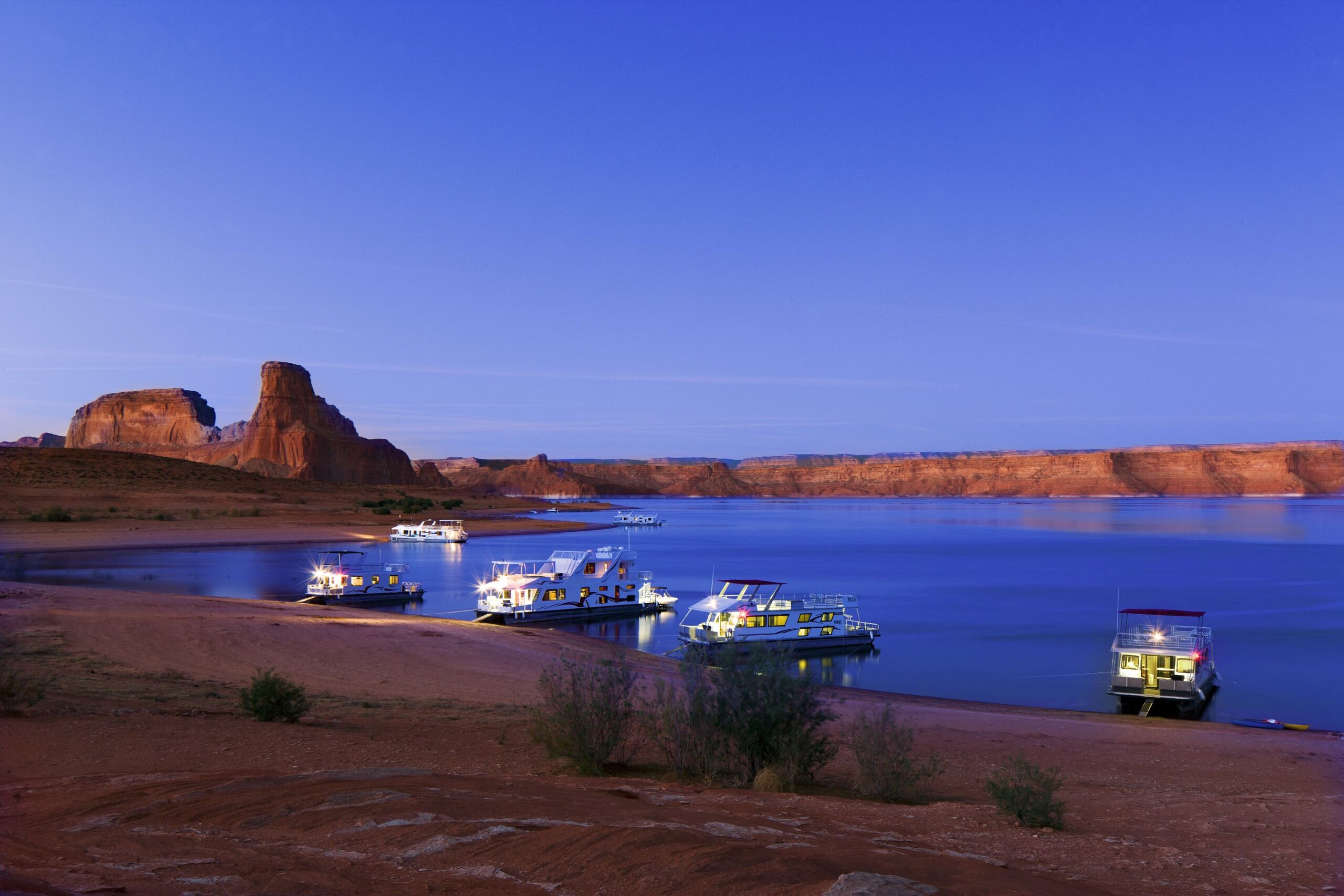
The Majesty of Lake Powell & Glen Canyon
Writers Joseph J. Airdo and Amanda Christmann



In the heart of red rock country, where terracotta cliffs rise dramatically from barren earth, lies one of the American Southwest’s most breathtaking paradoxes: a vast expanse of crystal blue water cutting through an arid desert landscape. Lake Powell and the surrounding Glen Canyon National Recreation Area represent Arizona’s largest aquatic playground — a 1.25 million-acre wonderland straddling the Arizona-Utah border that offers visitors an unparalleled combination of natural beauty, rich history and recreational opportunities.
The journey to this extraordinary destination takes travelers on a transformative expedition through Arizona’s changing landscape. Heading north from Phoenix on Interstate 17, the urban sprawl gives way to high country pines around Flagstaff before the terrain transforms dramatically along Highway 89A. As visitors approach the Vermilion Cliffs, the towering pines disappear entirely, replaced by a mesmerizing panorama of sandstone formations ablaze in the afternoon sun.
Near Cameron, Arizona — about 3 1/2 hours north of Phoenix — stands a century-old trading post and historic suspension bridge. When built in 1911, the 680-foot-long Cameron Bridge held the distinction of being the longest suspension bridge west of the Mississippi. According to local lore, in 1937, a massive flock of sheep crossing the bridge nearly caused its collapse — a testament to the bridge’s significance in connecting these isolated lands.
The northern Arizona landscape, now held by the Navajo Nation, has been walked upon by humans for as many as 10,000 years. For Indigenous peoples, this land’s sanctity predates written history. The stark beauty and seemingly inhospitable conditions belie the fact that civilizations have not merely survived here but thrived for millennia.
A Bridge to the Past
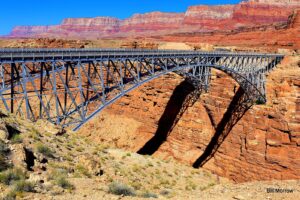


The true gateway to Glen Canyon comes into view at Marble Canyon, where twin bridges span a dramatic gorge. The Navajo Bridge, with its rust-colored steel arch contrasting against the azure sky, represents more than just an engineering feat — it stands as a crucial link in the region’s development story.
The history of human passage through this rugged terrain centers around Lees Ferry, 9 miles from Navajo Bridge. In 1870, Mormon pioneers seeking to expand into northern Arizona faced a formidable obstacle: the Colorado River. At the mouth of Glen Canyon, they discovered a relatively safe crossing point that would become known as Lees Ferry, named for John D. Lee.
Lee, appointed by Mormon Church President Brigham Young, established a ferry service at this strategic location. His assignment to this remote outpost carried additional significance — Lee had been implicated in the 1857 Mountain Meadows Massacre, and some historians suggest this isolated posting offered him a place to avoid scrutiny. The strategy proved unsuccessful; Lee was executed by firing squad in 1877.
For decades, Lees Ferry served as the sole crossing point along a vast stretch of the Colorado River. As automobiles replaced horse-drawn wagons, the need for a modern bridge became increasingly apparent. Construction began on what was initially called the Grand Canyon Bridge, spanning 800 feet across the river at Marble Canyon.
Tragedy struck in the summer of 1928 when the ferry at Lees Ferry sank, taking with it a Ford Model T and claiming three lives. For 18 months afterward, no crossing existed between Utah and Arizona for 800 miles. The completion of Navajo Bridge in January 1929 marked a momentous occasion, celebrated with a ceremony attended by an estimated 7,000 people, including the governors of Arizona, New Mexico and Utah. Local lore records that in a nod to the Prohibition era, the bridge was christened with ginger ale rather than champagne.
By 1993, increasing traffic necessitated construction of a new, wider bridge. The original structure was preserved as a pedestrian walkway, offering visitors spectacular views from 467 feet above the Colorado River.
The Birth of an Aquatic Wonder



No discussion of Glen Canyon would be complete without examining its crown jewel: Lake Powell. This vast reservoir, stretching 186 miles with nearly 2,000 miles of shoreline, ranks among North America’s largest man-made lakes. Its labyrinthine waterways include more than 96 major side canyons, with water depths reaching 561 feet at its deepest point.
The lake’s creation began with a button push from President Dwight D. Eisenhower’s Oval Office desk on Oct. 1, 1956, initiating the blasting for Glen Canyon Dam. The controversial project, spearheaded by the U.S. Bureau of Reclamation, aimed to harness hydroelectric power from the Colorado River. Over seven years, workers poured more than 4.9 million cubic yards of concrete to create the 710-foot-high dam, at a cost of $155 million in 1963 dollars (approximately $1.1 billion today) and 18 human lives. The vast reservoir behind it took 17 years to fill completely.
The dam’s completion forever altered the landscape, submerging ancient geological formations and archaeological sites beneath the turquoise waters. The reservoir was named for John Wesley Powell, the one-armed Civil War veteran and explorer who led the first documented expedition through the Grand Canyon in 1869. Despite the environmental controversy surrounding its creation, Lake Powell’s dazzling beauty and recreational opportunities have made it one of the Southwest’s premier destinations.
Exploring the Azure Playground
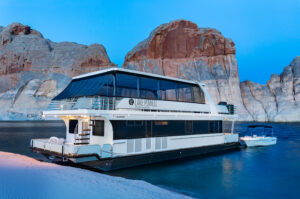


The most immersive way to experience Lake Powell is aboard a houseboat — a floating vacation home that allows visitors to navigate the lake’s hidden coves and beaches at a leisurely pace. Rental options range from basic 46-foot vessels sleeping six people to luxurious 75-foot craft complete with hot tubs, comfortable staterooms and waterslides. Many houseboats can tow smaller watercraft, allowing for side adventures on Jet Skis, kayaks or paddleboards.
For newcomers to houseboating, Lake Powell Resorts & Marina offers a Houseboating 101 course that provides comprehensive orientation on navigating, beaching and operating these vessels. The course includes practice sessions on the water and instruction on how to properly secure and tow an accompanying powerboat.
Visitors seeking land-based accommodations find Page, Arizona, the perfect base for exploring the lake. The Hyatt Place Page/Lake Powell serves as an ideal headquarters, offering immediate access to 10 national parks, 16 national monuments and more than 20 scenic byways. The hotel features an outdoor pool, lounge patio seating with fire pits, and a signature restaurant, Prickly Pear Kitchen, serving Southwestern-inspired cuisine. Their prickly pear margarita — crafted with Espolon tequila, triple sec, prickly pear puree, citrus sour and black lava salt—provides the perfect refreshment after a day on the water.
Adventure outfitters in Page offer various excursions, including paddle boarding trips with Big Orange Jeep Tours and Rentals. Their equipment includes life jackets and iRocker inflatable stand-up paddleboards, perfect for exploring the lake’s calm waters. For those seeking land-based adventures, Ken’s Lower Antelope Canyon Tours provides guided treks through one of the world’s most photographed slot canyons, led by knowledgeable Navajo guides who share the area’s geology and cultural history.
Natural Wonders and Hidden Treasures
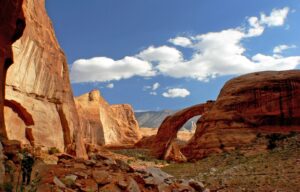


Lake Powell’s vast expanse contains numerous landmarks and destinations worthy of exploration. Rainbow Bridge, located in the Utah section of the lake, ranks among the most impressive. This natural sandstone arch, sacred to Native Americans for thousands of years, is accessible by boat or by a permit-required hike from the Rainbow Bridge Recreation Area dock.
Other must-visit destinations include:
- Antelope Canyon — This photogenic slot canyon requires a Navajo guide to visit. Summer is the ideal time when high sun angles create dramatic light beams piercing through the narrow openings to illuminate the canyon floor.
- Face Canyon — This narrow passage in the Utah portion of the lake offers perfect conditions for kayaking and paddleboarding through towering red rock walls.
- Gunsight Canyon — Just a couple of hours by houseboat from Wahweap Marina, this area features 2 miles of sandy beaches perfect for swimming and shoreline relaxation. The distinctive Gunsight Butte, resembling the sight of a gun, makes this spot easy to locate.
- Navajo Canyon — Lake Powell’s longest side canyon invites visitors to disembark and hike among copper-hued rocks to discover ancient petroglyphs.
- Padre Bay — This 9-mile-long expanse contains hidden coves and swimming holes, as well as iconic viewpoints featuring Cookie Jar Butte, Tower Butte and Boundary Butte.
- West Canyon — Known as one of the Colorado Plateau’s premier adventures, this narrow slot canyon requires scrambling, wading and swimming to navigate fully. Though challenging, the journey rewards visitors with breathtaking scenery.
For those interested in backpacking and camping, Escalante and Orange Cliffs provide excellent options for rugged adventure. Their steep canyons and pristine wilderness create an ideal backdrop for outdoor exploration. Visitors can obtain information about these areas, along with details about day hikes and other attractions, from several visitor centers throughout the recreation area.
Planning Your Lake Powell Adventure
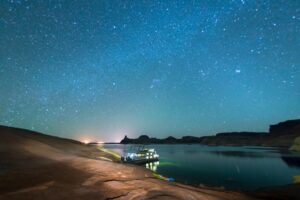


The drive to Wahweap Marina in Page from Phoenix takes approximately four to five hours. The route follows Interstate 17 north to Flagstaff, then Interstate 40 east to U.S. Route 89 north. After passing over Glen Canyon Dam in Page, continue to mile marker 550 and turn right into Wahweap South Entrance at Glen Canyon National Recreation Area. An entrance fee or National Parks pass is required.
Whether visiting for a day trip or an extended vacation, Glen Canyon National Recreation Area delivers an unmatched combination of natural splendor and recreational opportunities. The juxtaposition of azure waters against dramatic red rock formations creates a visual feast, while the area’s rich human history adds depth to the experience. From houseboating on Lake Powell to exploring ancient slot canyons, this remarkable destination offers memories that will last a lifetime.

